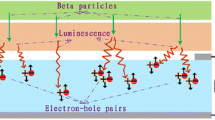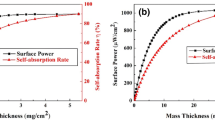Abstract
Betavoltaic nuclear batteries offer a promising alternative energy source that harnesses the power of beta particles emitted by radioisotopes. To satisfy the power demands of microelectromechanical systems (MEMS), 3D structures have been proposed as a potential solution. Accordingly, this paper introduces a novel 3D 63Ni–SiC-based P+PNN+ structure with a multi-groove design, avoiding the need for PN junctions on the inner surface, and thus reducing leakage current and power losses. Monte Carlo simulations were performed considering the fully coupled physical model to extend the electron–hole pair generation rate to a 3D structure, enabling the efficient design and development of betavoltaic batteries with complex 3D structures. As a result, the proposed model produces the significantly higher maximum output power density of 19.74 µW/cm2 and corresponding short-circuit current, open-circuit voltage, and conversion efficiency of 8.57 µA/cm2, 2.45 V, and 4.58%, respectively, compared with conventional planar batteries. From analysis of the carrier transport and collection characteristics using the COMSOL Multiphysics code, we provide deep insights regarding power increase, and elucidate the discrepancies between the ideal and simulated performances of betavoltaic batteries. Our work offers a promising approach for the design and optimization of high-output betavoltaic nuclear batteries with a unique 3D design, and serves as a valuable reference for future device fabrication.








Similar content being viewed by others
Data availability
The data that support the findings of this study are openly available in Science Data Bank at https://www.doi.org/10.57760/sciencedb.j00186.00275 and https://cstr.cn/31253.11.sciencedb.j00186.00275.
References
W.Z. Yuan, D.Y. Qiao, Micro-Electro-Mechanical System (MEMS) Manufacturing Technology (Science Press, Beijing, 2014)
C. Thomas, S. Portnoff, M.G. Spencer, High efficiency 4H-SiC betavoltaic power sources using tritium radioisotopes. Appl. Phys. Lett. 108, 013505 (2016). https://doi.org/10.1063/1.4939203
S.G. Kim, S. Priya, I. Kanno, Piezoelectric MEMS for energy harvesting. MRS Bull. 37, 1039–1050 (2012). https://doi.org/10.1557/mrs.2012.275
O.M. Barham, Comparing nuclear and chemical power sources for MEMS/NEMS applications. in ASME 2021 International Design Engineering technical Conferences and Computers and Information in Engineering Conference. Volume 11: 15th International Conference on Micro- and Nanosystems (MNS), (2021). https://doi.org/10.1115/detc2021-68110
A.V. Sachenko, A.I. Shkrebtii, R.M. Korkishko et al., Efficiency analysis of betavoltaic elements. Solid State Electron. 111, 147–152 (2015). https://doi.org/10.1016/j.sse.2015.05.042
H.Y. Chen, L. Jiang, X.Y. Chen, Design optimization of GaAs betavoltaic batteries. J. Phys. D Appl. Phys. 44, 215303 (2011). https://doi.org/10.1088/0022-3727/44/21/215303
M. Lu, G.-G. Zhang, K. Fu et al., Gallium nitride Schottky betavoltaic nuclear batteries. Energ. Convers. Manage. 52, 1955–1958 (2011). https://doi.org/10.1016/j.enconman.2010.10.048
T.R. Alam, M.A. Pierson, M.A. Prelas, Beta particle transport and its impact on betavoltaic battery modeling. Appl. Radiat. Isotopes. 130, 80–89 (2017). https://doi.org/10.1016/j.apradiso.2017.09.009
S.I. Maximenko, J.E. Moore, C.A. Affouda et al., Optimal semiconductors for 3H and 63Ni betavoltaics. Sci. Rep. 9, 10892 (2019). https://doi.org/10.1038/s41598-019-47371-6
C. Zhao, F. Liao, K. Liu et al., Breaking the myth: wide-bandgap semiconductors not always the best for betavoltaic batteries. Appl. Phys. Lett. 119, 153904 (2021). https://doi.org/10.1063/5.0068269
C. Zhao, A. Liu, S. Bai et al., Understanding efficiency differences of betavoltaic batteries measured by electron gun mimicked source and radioactive β source. Appl. Phys. Lett. 117, 193901 (2020). https://doi.org/10.1063/5.0028450
A. Belghachi, K. Bozkurt, O. Ozdemir et al., Enhancement of Ni-63 planar source efficiency for betavoltaic batteries. J. Phys. D Appl. Phys. 53, 445501 (2020). https://doi.org/10.1088/1361-6463/ab9977
X.B. Tang, D. Ding, Y.P. Liu et al., Optimization design and analysis of Si–63Ni betavoltaic battery. Sci. China Tech. Sci. 55, 990–996 (2012). https://doi.org/10.1007/s11431-012-4752-6
F. Bouzid, S. Dehimi, M. Hadjab et al., Performance prediction of AlGaAs/GaAs betavoltaic cells irradiated by nickel-63 radioisotope. Physica B 607, 412850 (2021). https://doi.org/10.1016/j.physb.2021.412850
R.Z. Zheng, J.B. Lu, Y. Wang et al., Understanding efficiency improvements of betavoltaic batteries based on 4H–SiC, GaN, and diamond. Appl. Phys. Lett. 121, 103902 (2022). https://doi.org/10.1063/5.0102995
Y.M. Liu, J.B. Lu, X.Y. Li et al., A 4H–SiC betavoltaic battery based on a 63Ni source. Nucl. Sci. Tech. 29, 168 (2018). https://doi.org/10.1007/s41365-018-0494-x
L. Zhang, H.L. Cheng, X.C. Hu et al., Model and optimal design of 147Pm SiC-based betavoltaic cell. Superlattice. Microst. 123, 60–70 (2018). https://doi.org/10.1016/j.spmi.2018.01.007
G.Q. Wang, H. Li, Y. Lei et al., Demonstration of Pm-147 GaN betavoltaic cells. Nucl. Sci. Tech. 25, 020403 (2014). https://doi.org/10.13538/j.1001-8042/nst.25.020403
C.E. Munson, Q. Gaimard, K. Merghem et al., Modeling, design, fabrication and experimentation of a GaN-based, 63Ni betavoltaic battery. J. Phys. D Appl. Phys. 51, 035101 (2018). https://doi.org/10.1088/1361-6463/aa9e41
A. Krasnov, S. Legotin, K. Kuzmina et al., A nuclear battery based on silicon pin structures with electroplating 63Ni layer. Nucl. Eng. Technol. 51, 1978–1982 (2019). https://doi.org/10.1016/j.net.2019.06.003
Y. Liu, R. Hu, Y. Yang et al., Investigation on a radiation tolerant betavoltaic battery based on Schottky barrier diode. Appl. Radiat. Isotopes. 70, 438–441 (2012). https://doi.org/10.1016/j.apradiso.2011.10.013
H. Guo, Y. Shi, Y. Zhang et al., Fabrication of SiC p–i–n betavoltaic cell with 63Ni irradiation source. in 2011 IEEE International Conference of Electron Devices and Solid-State Circuits. (2011), pp. 1–2. https://doi.org/10.1109/EDSSC.2011.6117636
S. Yao, Z. Song, X. Wang et al., Design and simulation of betavoltaic battery using large-grain polysilicon. Appl. Radiat. Isotopes. 70, 2388–2394 (2012). https://doi.org/10.1016/j.apradiso.2012.06.009
G. Gui, K. Zhang, J.P. Blanchard et al., Prediction of 4H-SiC betavoltaic microbattery characteristics based on practical Ni-63 sources. Appl. Radiat. Isotopes. 107, 272–277 (2016). https://doi.org/10.1016/j.apradiso.2015.11.001
Z.J. Cheng, X.Y. Chen, H.S. San et al., A high open-circuit voltage gallium nitride betavoltaic microbattery. J. Micromech. Microeng. 22, 074011 (2012). https://doi.org/10.1088/0960-1317/22/7/074011
W. Sun, N.P. Kherani, K.D. Hirschman et al., A three-dimensional porous silicon p–n diode for betavoltaics and photovoltaics. Adv. Mater. 17, 1230–1233 (2005). https://doi.org/10.1002/adma.200401723
A.A. Krasnov, V.V. Starkov, S.A. Legotin et al., Development of betavoltaic cell technology production based on microchannel silicon and its electrical parameters evaluation. Appl. Radiat. Isotopes. 121, 71–75 (2017). https://doi.org/10.1016/j.apradiso.2016.12.019
J.W. Murphy, C.D. Frye, R.A. Henderson et al., Demonstration of a three-dimensionally structured betavoltaic. J. Electron. Mater. 50, 1380–1385 (2021). https://doi.org/10.1007/s11664-020-08611-y
Z. Ding, T.X. Jiang, R.R. Zheng et al., Quantitative modeling, optimization, and verification of 63Ni-powered betavoltaic cells based on three-dimensional ZnO nanorod arrays. Nucl. Sci. Tech. 33, 144 (2022). https://doi.org/10.1007/s41365-022-01127-6
A.A. Krasnov, S.A. Legotin, Advances in the development of betavoltaic power sources (a review). Instrum. Exp. Tech+. 63, 437–452 (2020). https://doi.org/10.1134/s0020441220040156
Y.J. Yoon, J.S. Lee, I.M. Kang et al., Design and optimization of GaN-based betavoltaic cell for enhanced output power density. Int. J. Energ. Res. 45, 799–806 (2021). https://doi.org/10.1002/er.5909
F. Rahmani, H. Khosravinia, Optimization of silicon parameters as a betavoltaic battery: comparison of Si pn and Ni/Si Schottky barrier. Radiat. Phys. Chem. 125, 205–212 (2016). https://doi.org/10.1016/j.radphyschem.2016.04.012
W. Li, K. Nomoto, Z. Hu et al., Field-plated Ga2O3 Trench Schottky barrier diodes with a BV2/Ron, sp of up to 0.95 GW/cm2. IEEE Electr. Dev. L. 41, 107–110 (2019). https://doi.org/10.1109/LED.2019.2953559
J. Yota, H. Shen, R. Ramanathan, Characterization of atomic layer deposition HfO2, Al2O3, and plasma-enhanced chemical vapor deposition Si3N4 as metal-insulator-metal capacitor dielectric for GaAs HBT technology. J. Vac. Sci. Technol. A 31, 01A134 (2013). https://doi.org/10.1116/1.4769207
N. Alimardani, J.F. Conley, Enhancing metal-insulator-insulator-metal tunnel diodes via defect enhanced direct tunneling. Appl. Phys. Lett. 105, 082902 (2014). https://doi.org/10.1063/1.4893735
R. Singh, T.R. Lenka, D.K. Panda et al., The dawn of Ga2O3 HEMTs for high power electronics: a review. Mat. Sci. Semicon. Proc. 119, 105216 (2020). https://doi.org/10.1016/j.mssp.2020.105216
D.Y. Qiao, W.Z. Yuan, P. Gao et al., Demonstration of a 4H SiC betavoltaic nuclear battery based on Schottky barrier diode. Chin. Phys. Lett. 25, 3798 (2008). https://doi.org/10.1088/0256-307X/25/10/076
X.Y. Li, Y. Ren, X.J. Chen et al., 63Ni schottky barrier nuclear battery of 4H-SiC. J. Radioanal. Nucl. Ch. 287, 173–176 (2011). https://doi.org/10.1007/s10967-010-0746-7
K. Vanthanh, Y.C. Ma, J.H. Si et al., Fabrication of micro-grooves in silicon carbide using femtosecond laser irradiation and acid etching. Chin. Phys. Lett. 31, 037901 (2014). https://doi.org/10.1088/0256-307X/31/3/037901
B.J. Baliga, Fundamentals of Power Semiconductor Devices (Springer Science & Business Media, 2010)
A.A. Svintsov, A.A. Krasnov, M.A. Polikarpov et al., Betavoltaic battery performance: comparison of modeling and experiment. Appl. Radiat. Isotopes. 137, 184–189 (2018). https://doi.org/10.1016/j.apradiso.2018.04.010
C. Zhao, L. Lei, F.Y. Liao et al., Efficiency prediction of planar betavoltaic batteries basing on precise modeling of semiconductor units. Appl. Phys. Lett. 117, 263901 (2020). https://doi.org/10.1063/5.0033052
S. Mohamadian, S. Feghhi, H. Afarideh, Analyze and simulation of a typical MEMS RPG using MCNP code. Int. Conf. Nucl. Eng. 48140, 883–886 (2008). https://doi.org/10.1115/ICONE16-48766
X. Li, N.P. Hylton, V. Giannini et al., Multi-dimensional modeling of solar cells with electromagnetic and carrier transport calculations. Prog. Photovolt. 21, 109–120 (2013). https://doi.org/10.1002/pip.2159
Q.J. Meng, H.B. Liu, Q.H. Meng, Physics of Semiconductor Devices (Science Press, Beijing, 2005)
M. Grundmann, Diodes. in M. Grundmann (Ed.) The Physics of Semiconductors: An Introduction Including Nanophysics and Applications. (Springer International Publishing, Cham, 2016), pp. 583–667. https://doi.org/10.1007/978-3-319-23880-7_21
T. Okuda, T. Miyazawa, H. Tsuchida et al., Carrier lifetimes in lightly-doped p-Type 4H-SiC epitaxial layers enhanced by post-growth processes and surface passivation. J. Electron. Mater. 46, 6411–6417 (2017). https://doi.org/10.1007/s11664-017-5677-4
J. Zhang, L. Storasta, J.P. Bergman et al., Electrically active defects inn-type 4H–silicon carbide grown in a vertical hot-wall reactor. J. Appl. Phys. 93, 4708–4714 (2003). https://doi.org/10.1063/1.1543240
B.J. Baliga, The Igbt Device: Physics, Design and Applications of the Insulated Gate Bipolar Transistor (Elsevier, Waltham, 2015)
O. Kordina, J.P. Bergman, C. Hallin et al., The minority carrier lifetime of n-type 4H- and 6H-SiC epitaxial layers. Appl. Phys. Lett. 69, 679–681 (1996). https://doi.org/10.1063/1.117804
P. Ščajev, K. Jarašiūnas, Temperature- and excitation-dependent carrier diffusivity and recombination rate in 4H–SiC. J. Phys. D Appl. Phys. 46, 265304 (2013). https://doi.org/10.1088/0022-3727/46/26/265304
Author information
Authors and Affiliations
Contributions
All authors contributed to the study conception and design. Material preparation, data collection and analysis were performed by Hou-Jun He, Yun-Cheng Han, Xiao-Yu Wang, Yu-Min Liu, Jia-Chen Zhang, Lei Ren and Ming-Jie Zheng. The first draft of the manuscript was written by Hou-Jun He and all authors commented on previous versions of the manuscript. All authors read and approved the final manuscript.
Corresponding authors
Ethics declarations
Conflict of interest
The authors declare that they have no competing interests.
Additional information
This work was supported by Anhui Provincial Key R&D Program (No. 202104g0102007), Jiangxi Provincial Department of Education Science and Technology Research Youth Project (GJJ200763), Hubei Provincial Natural Science Foundation of China (No. 2022CFB575), Hefei Municipal Natural Science Foundation (No. 2022011); Ministry of Education Industry-Education Cooperation Project (No. 202102647014), Science Island Graduate Innovation and Entrepreneurship Fund Project (No. KY-2022-SC-04).
Supplementary Information
Below is the link to the electronic supplementary material.
Rights and permissions
Springer Nature or its licensor (e.g. a society or other partner) holds exclusive rights to this article under a publishing agreement with the author(s) or other rightsholder(s); author self-archiving of the accepted manuscript version of this article is solely governed by the terms of such publishing agreement and applicable law.
About this article
Cite this article
He, HJ., Han, YC., Wang, XY. et al. Enhancing betavoltaic nuclear battery performance with 3D P+PNN+ multi-groove structure via carrier evolution. NUCL SCI TECH 34, 181 (2023). https://doi.org/10.1007/s41365-023-01331-y
Received:
Revised:
Accepted:
Published:
DOI: https://doi.org/10.1007/s41365-023-01331-y




